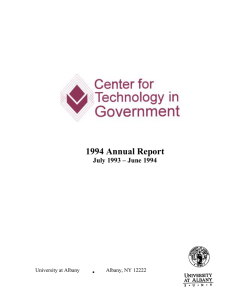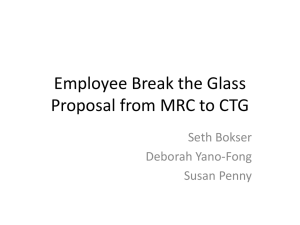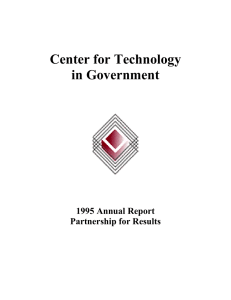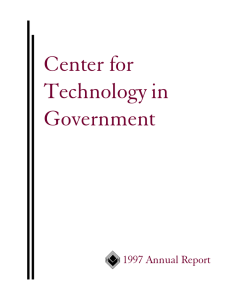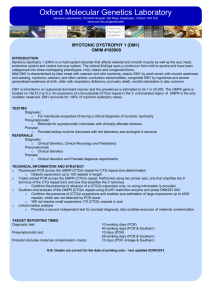Center for Technology in Government 1996 Annual Report
advertisement
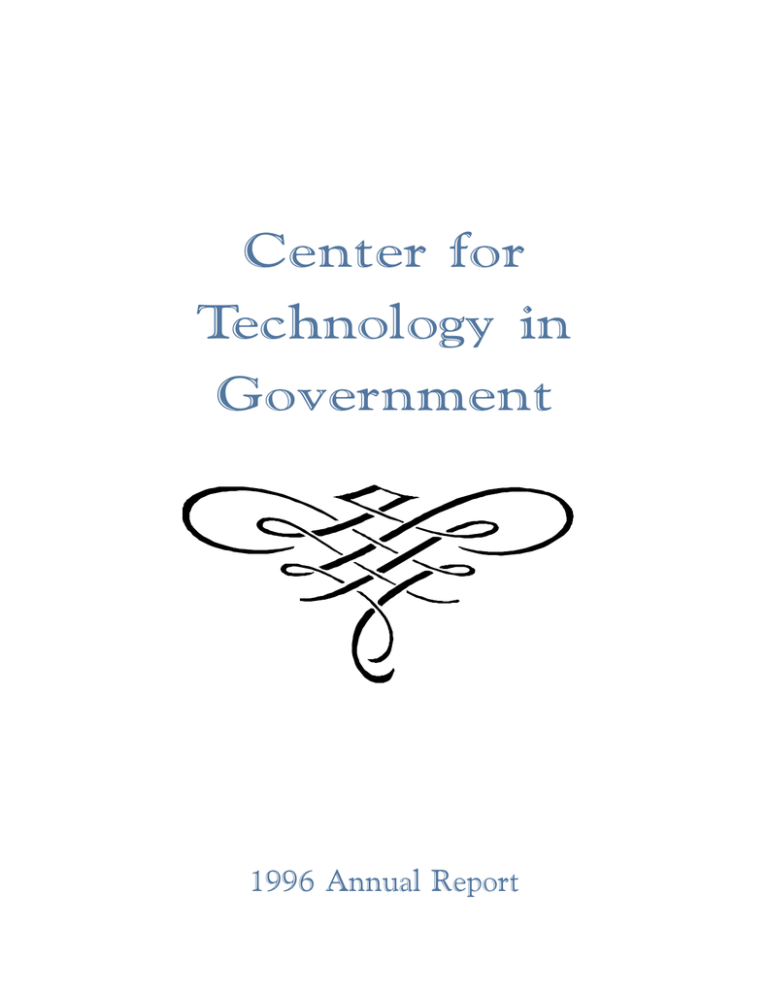
1996 Annual Report Center for Technology in Government 1996 Annual Report Center for Technology in Government Center for Technology in Government 1996 Annual Report July 1995 - June 1996 1996 Annual Report The Center for Technology in Government pursues new ways of applying computing and communications technologies to the practical problems of information management and service delivery in the public sector. The Center's program seeks to reduce the costs and improve the quality of government services, reduce the risks of innovation, and share the results of its projects throughout the public sector. Center for Technology in Government July 1996 Dear Colleague: The past twelve months have been exciting ones for everyone associated with the Center for Technology in Government. As our program year opened in July 1995, we found ourselves at Harvard University presenting the CTG story to the Innovations in American Government National Selection Panel. To our great delight, CTG was named one of fifteen award winners honored for programs that represent exemplary solutions to important public problems. Since that time, we have responded to requests from around the world for information about CTGs approach to using information technology to improve the delivery of government services. Weve assisted callers from as far away as Korea and Brazil and from as nearby as New York City and Oswego County, NY. We are proud of this prestigious award, but even more proud and grateful for the many people and organizations who helped design and build CTG. Two major projects were completed this year. One, conducted in cooperation with the Office of Mental Health, focused on improving psychiatric assessments in emergency rooms. The other, initiated by the Department of Environmental Conservation, produced the award-winning New York State Spatial Data Clearinghouse. A third project, now nearing completion, involves ten state and local agencies in an exploration of the Internet as a means of delivering information and services. These Internet Testbeds are being conducted in cooperation with many corporate partners and the Governors Task Force on Information Resource Management. As always, our projects depend on the generosity and imagination of agency, corporate, and university partners. This year we welcomed Deloitte & Touche, EMI Communications, Eric Elgar Consulting, Inteligis Corporation, and MultiTech Systems to our corporate partner roster. Faculty, staff, and students from the University at Albany, the University at Buffalo, and Hudson Valley Community College all contributed to the research and evaluation phases of our projects. The officers, staff, and members of the New York State Forum for Information Resource Management continue to be a rich source of ideas, resources, and advice. We have truly had a banner year at CTG and invite you to join us in the exciting work that lies ahead. Sincerely Sharon S. Dawes Director 1996 Annual Report Innovations in American Government Award This country is bursting with pride in your accomplishments. Vice President Gore October 26, 1995 Vice President Al Gore honored the Center for Technology in Government during a ceremony in Washington DC. President Clinton met with the CTG delegation and other winners in the Rose Garden. T he Center for Technology in Government received a 1995 Innovations in American Government Award. Presented to organizations that demonstrate the best in American Government, the prestigious award is administered by the Ford Foundation and the John F. Kennedy School of Government at Harvard University. The $100,000 grant that accompanies the honor is earmarked for replication and information programs so that others may benefit from CTGs results. The Innovations Award is a tribute to the vision and initiative of CTGs government colleagues, the creative energy of the University community, and the service and technology contributions of the private sector. Page 2 Center for Technology in Government Working Together for Good Government Government University Business T T B his year marked an important transition in the kinds of projects and range of government partners involved in work at the Center. While early projects focused on a critical service objective for a single agency, we are now engaged in work that crosses the boundaries of many government organizations. The recently completed GIS Cooperative Project involved more than 450 representatives of state, local, and federal governments in creating a government-wide information resource, the NYS Spatial Data Clearinghouse. The Internet Testbeds, now underway, directly involve ten state and local agencies and indirectly will assist all governments in New York through the creation and dissemination of practical guidelines for using the WWW to deliver services. omorrows leaders are todays university students. At CTG, students are often responsible for the creative ideas and technical expertise that go into project prototypes. Faculty contribute to the research and evaluation phase of every project and this year included faculty and staff from the University at Buffalo and Hudson Valley Community College as well as Albany. Students and faculty associated with Albanys interdisciplinary program in information science, have key roles as CTG graduate assistants and staff. They were joined this year by graduate students in computer science, geography, management science and information systems, public administration and political science. usiness support for the Center is critical to our success. Inkind corporate contributions of the latest technologies allow us to tackle a range of projects that would not be possible under ordinary circumstances. This year our Government Technology Solutions Laboratory, equipped almost entirely from corporate contributions, has reached a high state of maturity. New projects can now take full advantage of the robust and flexible infrastructure that past contributions have made possible. At the same time, new equipment, software, and consulting services expand and refresh this state-of-the-art facility. CTG staff members helped state and local governments develop World Wide Web site prototypes. Page 3 1996 Annual Report Recently Completed Projects Sharing the Costs, Sharing the Benefits: The NYS Geographic Information Systems Cooperative Project U nderstanding spatial relationships is essential for strategic planning and effective delivery of government services. Governments rely on geographic information systems (GIS) for a vast array of purposes, from land use management to emergency services. The value of GIS and spatial data can be seen most dramatically in applications that promote economic development, public health and safety, and environmental quality. Often organizations with similar needs can share information and achieve considerable efficiencies and other benefits. CTG and the NYS Department of Environmental Conservation were joined by the New York State Temporary GIS Council and many others in designing a framework for GIS coordination and developing the NYS Spatial Data Clearinghouse. Government Partners NYS Department of Environmental Conservation NYS Forum for Information Resource Management Erie County Water Authority NYS Division of the Budget State Archives and Records Administration Corporate Partners Applied GIS, Inc. Blue Moon Training Systems Digital Equipment Corporation Documentation Strategies, Inc. Full Circle Communications Harlan Wallach Graphic Arts Inteligis Corporation Sun Microsystems Unified Technologies Xyplex Academic Partners University at Albany National Center for Geographic Information & Analysis, University at Buffalo Page 4 The project demonstrated the depth and variety of existing human, technical, and data resources in New York State. It showed the extent to which spatial data needs overlap among key policy and application areas and examined how data sharing strategies can reduce the cost and increase the value of GIS at every level of government and in the private sector. The project identified existing federal, local, and regional coordination efforts, and it developed specific recommendations for overcoming barriers to data sharing and coordination. The Center played a leading role in designing and creating the NYS Spatial Data Clearinghouse, an Internet-based repository of metadata describing the spatial data holdings of federal, state, local, and private organizations. It is an ideal sharing mechanism that helps GIS developers find and use data that someone else has already developed. The Clearinghouse can be found on the World Wide Web at http://www.ctg.albany.edu/gisny.html The Clearinghouse won a 1996 NASIRE recognition award for outstanding achievement in information technology. It was honored as the best intergovernmental application among the 50 states. Center for Technology in Government Office of Mental Health Project: Supporting Psychiatric Assessments in Emergency Rooms The New York State Office of Mental Health (OMH), the Center for Technology in Government, and the Center for Policy Research worked together to address this issue through the development of a computerassisted decision model to support psychiatric assessments in emergency rooms. An expert panel representing both psychiatric health professionals and consumers of mental health services helped design the model. The decision support model and resulting software system are not meant to replace the physician or the physicians own expert judgment. Instead, they support the practitioner in gathering and considering all information relevant to an admissions decision. The project enhanced understanding of the emergency room process, including how it differs from setting to setting. Also important to OMH, the project demonstrated that physicians can benefit from using computer software. This knowledge has important value as a guide for further efforts to improve emergency psychiatry, which may include the use of information technology. The field test at the Psychiatric Institute of Westchester Medical Center suggested that the software might have special value as a training tool for mental health and human service professionals and resulted in a number of other recommendations for refinement and further development. Government Partners Office of Mental Health Corporate Partners Microsoft Corporation Borland International Digital Equipment Corporation IBM Corporation Academic and Non Profit Partners Center for Policy Research, UAlbany Westchester Medical Center Psychiatric Institute Photo by Current Rutledge A n inappropriate decision to admit or discharge a psychiatric patient from an emergency room is often the starting point for a series of undesirable results. The individual inappropriately admitted is deprived of liberty and involved in a disruptive, stigmatizing event. Since each admission to inpatient psychiatric care costs the mental health system about $10,000, these admissions are also a costly misuse of scarce health care dollars. A patient who needs help and is not admitted, however, goes without care and may cause harm to self or others. Over 135,000 emergency psychiatric assessments are conducted in New Yorks hospitals each year, and research shows wide variability in the resulting admission and discharge decisions. Decision support software supports psychiatric assessments in emergency rooms. Page 5 1996 Annual Report Increasing Access, Safeguarding Information: Works in Progress Electronic Records M Participants at the June 1996 Internet Testbed Project demonstration viewed the World Wide Web sites NYS agencies developed with CTG assistance. Internet Testbeds C ustomers can access Internet-based government services 24 hours per day, seven days a week. Agency staff can use the Internet to link remote offices to central agency databases and link agencies with suppliers and contractors, as well as exchange information with other governments. CTG has been working with ten state and local organizations and the Governors Task Force on Information Resource Management to investigate the technologies, processess, costs and benefits of relying on the Internet to deliver information and services. Through a series of workshops, seven agency Web teams learned how to plan for networked service delivery and how to design, develop, and evaluate their World Wide Web sites. These teams include: Empire State Development, Governors Traffic Safety Committee, Hamilton County, Division of Housing and Community Renewal, Division of Military and Naval Affairs, Office of Real Property Services, and Office of Alcoholism and Substance Abuse Services. In addition, CTG, the NYS Departments of Health and Transportation, the State University System Administration, and several corporate partners are examining security issues and the technical feasibility of adopting the Web as a universal interface to government information and services. Page 6 ost government information specialists in New York and elsewhere see doing business electronically as a way to overcome declining resources and meet rising public expectations for service. Technological changes, though, have a substantial impact on an agencys ability to create, manage and use electronic records to support legal responsibilities and business needs. CTG is now working with the State Archives and Records Administration, the Adirondack Park Agency, and University at Albany faculty members to develop and promote practical models that will handle electronic records management and archival requirements in computing and communications applications. This two year project is funded in part by a $140,000 grant from the National Historical Publications and Records Commission. Center for Technology in Government A Partnership for the Common Good T he Centers program is made possible by resources from public, private, and academic contributors. While state funds ($744,000 this year) remain the core of our operating budget, the value of total resources was nearly double that figure ($1.3 million). In-kind corporate, Total CTG Resources 1993-1996 agency, and university $8,000,000 contributions represented $340,000. Grants from the $7,000,000 Ford Foundation and the $6,000,000 Grants National Historical $5,000,000 Academic partners Publications and Records Corporate partners $4,000,000 Commission added $240,000. Government partners $3,000,000 During the last three years, NYS appropriation total resources equalled $7.4 $2,000,000 million (graph). Over that $1,000,000 period, our technical infrastructure has become one 1993-94 1993-95 1993-96 of our greatest assets, representing more than $2.5 million in hardware, software, and telecommunications including major loans and donations from Microsoft, Sun Microsystems, AT&T, Digital, Hewlett-Packard, Novell, and Bay Networks. The GIS and Psychiatric Assessment Projects, and the Internet Testbeds all relied on this excellent, versatile infrastructure. This year, 13 companies contributed new assistance worth nearly $100,000 (table), mostly in the form of education and consulting services that augment the value of our state-of-the-art facilities. More than 50 government professionals, academic experts, and non profit service providers gave generously of their time and expertise. The value of government ($205,000), and academic ($38,000) services totaled nearly a quarter million dollars this yearwithout considering the hundreds of people who participated in the research seminars associated with the GIS Project or the planning seminar that defined the Internet Testbeds. In -k in d C o rp o r a te C o n trib u tio n s fo r 1 9 9 5 -9 6 D elo itte & To u c h e $ D ig ita l E q u ip m e n t C o rp o ra tio n 5 ,2 0 0 D oc u m e n ta tion S tra te g ie s 2 ,3 0 0 E M I C o m m u n ic a tio n s 2 ,4 0 0 E ric E lg a r C o n su ltin g 2 ,0 0 0 F u ll C irc le C o m m u n ica tio n s 1 ,2 0 0 In te lig is C o rp or atio n The University at Albany continues to provide strong support for CTGs program. Graduate assistantships funded by the Office for Research and the Information Science Doctoral Program help us attract some of the best doctoral and masters students on campus. Faculty continue to contribute their time as consultants and student supervisors, and our President and Vice Presidents strongly support and encourage our applied research objectives. 4 ,0 0 0 525 M icr os o ft C o rp o ra tio n 4 ,9 2 9 M u ltiTe c h S y s te m s 1 3 ,8 9 6 N ov e ll 1 9 ,0 7 0 S u n M ic ro s ys te m s 3 6 ,5 0 0 U nifie d Te ch n o lo g ies 4 ,0 0 0 X y p le x 1 ,0 0 0 To ta l for 9 5 -9 6 $ 9 7 ,0 2 0 Page 7 1996 Annual Report CTG Information Products http://www.ctg.albany.edu CTG on the Web World Wide Web sites have become a popular way to communicate with government constituents and among units of government. CTG has been on the Web since early 1994 providing information about our organization, partners, projects, and connections to other government sites. In April 1996, the Center launched a new version of the Web site which is now deeper and richer in its information coverage. Between April and June, the site hosted more than 5,600 user sessions averaging 84 per day. The CTG Web site is organized into eight interlinked categories of information. Page 8 contains our mission statement, operating policies and other descriptive information. takes center stage in the site. Each project has its own menu, and each major document has a table of contents. Users can drill down to the information needed by clicking on the menu items. Long documents can be downloaded directly to the users computer. lists corporate, academic, and government partners and links to their Web sites. introduces our staff and fellows. describes the place where project prototypes are built. presents news and highlights updated features in any of the other categories. announces and provides a means to register for seminars and other happenings. is an extensive library of linked or downloadable resources such as project reports, bibliographies, other Web sites, and news items. Center for Technology in Government Newsletter Photo by Current Rutledge Last fall CTG developed a quarterly newsletter to keep our colleagues informed. As a new communications tool, Innovations reports on projects in process and presents results from seminars and events. Web site recommendations, hot information technology trends, and other resources are covered in each issue as well. CTG has already had requests to reprint sections of Innovations, and we continue to receive inquiries generated by newsletter stories. University faculty lend their expertise to CTG staff on research projects, seminar presentations, and reports. Video Publications Thanks to funding from the Ford Foundation, CTG has produced an eight-minute video that shows how the Center works. Improving Government through Partnerships and Technology features projects involving the Adirondack Park Agency, the Office of Mental Health, and the Internet Testbeds. It shows the roles played by partners and the interplay among policy, management, and technology issues that is at the heart of each project.The video is available for loan and is used often at conferences and educational programs. The following reports describing the results of CTG projects were issued during the year. All reports are available in print and digital formats. They can be downloaded from the Centers Web site, or ordered by phone or fax. Geogr aphic Infor mation System Cooper ative Pr oject ♦ Sharing the Costs, Sharing the Benefits: The NYS GIS Cooperative Project ♦ The New York State Spatial Data Clearinghouse Technical Report ♦ Compelling Reasons for GIS Coordination in NYS ♦ A Framework for Evaluating Public Sector Geographic Information Systems Adir ondack Par k Agency Pr oject ♦ Balancing Environmental Quality & Economic Vitality in the Adirondack Park ♦ Evaluating the APA Prototype: Prospects for Providing Cheaper, Faster, and Better Services to APAs Customers ♦ Using Technology to Change Work: Technical Results from the APA Prototype Office of Mental Health Pr oject ♦ Supporting Psychiatric Assessments in Emergency Rooms ♦ Report of the Field Test to Evaluate a Decision Support Tool for Psychiatric Assessments in Emergency Rooms Page 9 1996 Annual Report Looking Back on a Banner Year 1996 has indeed been a banner year at CTG. We completed two major projects and launched two new ones, conducted four public demonstrations of project prototypes, issued three project reports and associated working papers, launched an updated version of our Web site, and answered hundreds of queries from around the world. Photo by Current Rutledge During the past year, the Center and its projects have been featured in the New York Times, the Washington Post, Governing, Government Technology, Public Innovator, the Albany Times Union, the Troy Record, the Schenectady Daily Gazette, Empire State Report, Capital District Business Review, Government Computer News, NASIRE Exchange, and GIS World. Corporate partners provide consultation to CTG technical staff as they participate in the Centers projects. Staff gave presentations to an array of audiences including: Capital Area Chapter of the American Society for Public Administration, the U.S. Nuclear Regulatory Commission Technology Center, the State of Marylands Information Technology Support Center, the Institute for Operations Research and the Management Sciences, the NYS Local Government Information Technology Directors Association, the Adirondack Park Commission, and the Brookings Institution, just to name a few. In the past year the number of entries in our contact database has nearly doubled to more than 3,000. We receive an average of eight requests a week for general information packets or project reports and continue to receive requests for general and project specific information from around the world including more than 80 visits a day to our Web site. July 1995 The CTG program was presented to the Innovations in Amer ican Gover nment National Selection Panel at Harvard University, Cambridge, MA. Page 10 Center for Technology in Government Public demonstration of the Office of Mental Health Prototype, Making Psychiatr ic Assessments in Emer gency Rooms, was held at the UAlbany Executive Development Center. Representatives from a legislative commission, private hospitals, local government health care organizations, and several state agencies attended the program. August 1995 Photo by Current Rutledge Three half-day research seminars, conducted by the NYS GIS Cooper ative Pr oject, were held in Albany, Buffalo, and New York City to collect perspectives on issues related to statewide GIS coordination. More than 400 people representing the private, public, academic and not-for-profit sectors participated in these meetings. September 1995 CTG hosted an information and demonstration booth at the Gover nment Technology Conference held in Albany. Prototype demos, reports and information packets were provided to visitors who attended the annual three day event. Reengineering business processes can be as important as hardware and software solutions. CTG released the Suppor ting Psychiatr ic Assessments in Emer gency Rooms Project Report. Nearly 800 copies of the paper report were distributed and a digital version was made available on our Web site for downloading. October 1995 The New Yor k on the Inter net Wor kshop, held at the Empire State Plaza, was attended by more than 150 state and local agency representatives. Participants defined the goals of the Internet Testbeds and identified security on the Internet as the topic of greatest interest which led to our April, 1996 Security Day. Page 11 1996 Annual Report Shar ing the Costs, Shar ing the Benefits: NYS GIS Cooper ative Project Demonstr ation, held at the UAlbany Performing Arts Center, was attended by 153 people. The attendees represented 30 state agencies, 13 corporate partners, three legislative commissions and staff from the Assembly, Senate, and US Geological Survey. Speakers included representatives from the Federal Geographic Data Committee, National Center for Geographic Information and Analysis (University at Buffalo), Department of Environmental Conservation, and Applied GIS, Inc. CTG staff went to Washington for the Innovations in Amer ican Gover nment Awar d presentation and paid an unexpected visit to the White House. November 1995 First Government Technology Solutions Laboratory Open House was held. This informal program has become a monthly event. December 1995 First edition of Innovations Newsletter was mailed to 3,000 people across the country. Released Shar ing the Costs, Shar ing the Benefits: The NYS GIS Cooper ative Pr oject and Balancing Economic Vitality and Envir onmental Quality in the Adir donack Par k project reports on our Web site. More than 1,600 paper copies of these reports have been mailed to interested parties. January 1996 Staff support was provided to the NYS Tempor ar y GIS Council throughout the fall and winter culminating in a two day event in January. CTG staff helped draft portions of the Council report, Geographic Information Systems: Key to Competitiveness which was forwarded to the Legislature and Governor in March, 1996. The Kickoff for the Inter net Ser vices Testbed Pr oject was held. Seven state and local government agency teams participated in six workshops held over the following five months. The workshops consisted of presentations, exercises, hands-on tutorials focusing on the technology, and management and policy discussions associated with designing, developing, and managing Web-based services in their agencies. Corporate, academic, and agency partners provided speakers and other resources for the workshops. Page 12 Center for Technology in Government February 1996 CTG staff and fellows served as consultants in Lebanon, helping to plan the countrys information infrastructure. The U.S. Agency for Inter national Development Lebanon Pr oject was conducted through UAlbanys Center for Legislative Development. March 1996 Photo by Current Rutledge CTG received a two-year research grant from the National Histor ical Publications and Recor ds Commission entitled Models for Action: Developing Practical Approaches to Electronic Records Management and Preservation. April 1996 University at Albany graduate students in computer science, information science, and public administration learn while working on CTG research projects. Secur ity on the Inter net was held at Hudson Valley Community College. The day-long program was attended by more than 150 people, representing 42 NYS agencies, seven local governments, three academic institutions, and nine representatives from the private sector. Presentations were made by CTGs public sector and corporate partners including the NYS Health Department, Digital Equipment Corporation, Microsoft Corporation, Sun Microsystems, and Unified Technologies. June 1996 Developing Inter net-Based Ser vices: Management, Policy and Technology Issues in the Public Sector was held at the UAlbany Performing Arts Center. The half-day program was attended by more than 170 people, representing 44 NYS agencies, seven local governments, three academic institutions and five private organizations. Presentation focused on the technical, policy and management lessons for using this new and versatile technology to achieve service objectives. Six agency Web sites were demonstrated. Next year we look forward to completing the Internet Testbeds and the Electronic Records Project, and to launching new work that will help government managers design high quality, responsive, and cost-effective public services. Page 13 1996 Annual Report Center for Technology in Government Dir ector Sharon Dawes Team Leader s Peter Bloniarz, Research and Laboratory Director Sally Goodall, Operations Theresa Pardo, Projects Pr ofessional Staff Peter Avery, Systems Administrator Donna Berlin, Internet Coordinator Ann DiCaterino, Project Support Manager Winsome Foderingham-Hérard, Facility Manager Kristine Kelly, Research Associate Claire McInerney, Information Coordinator Derek Werthmuller, Systems Administrator Resear ch & Faculty Fellows David Andersen, Public Administration & Policy and Information Science Salvatore Belardo, Management Science & Information Systems Anthony Cresswell, Educational Administration & Policy and Information Science Thomas Galvin, Information Science Jeryl Mumpower, Center for Policy Research John Rohrbaugh, Public Administration & Policy Sandor Schuman, Public Administration & Policy Thomas Stewart, Center for Policy Research Gr aduate Assistants David Connelly, Public Administration & Policy David Filbert, Political Science Christian Harris, Computer Science Fazal Ilahi, Computer Science Kai Larsen, Information Science Ursula Marcus, Management Science & Information Systems Ranjana Syam, Management Science & Information Systems Mei-Huei Tang, Computer Science Wen-Li Wang, Computer Science Jihong Zeng, Information Science Xiaomin Zheng, Computer Science Student Assistants Monica Estrada, Criminal Justice & Political Science Michael Kersten, Biology Mari Anne Lavelle, History Tiara Miller, Africana Studies & Sociology Michelle Molina, Mathematics Sean Mornan, Political Science Funding for the pr oduction of this Annual Repor t was pr ovided in par t by the For d Foundation Center for Technology in Government CENTER FOR T ECHNOLOGY IN GOVERNMENT UNIVERSITY AT ALBANY, SUNY 1400 WASHINGTON AVE, PAC 264 ALBANY , NY 12222 PHONE: (518) 442-3892 FAX: (518) 442-3886 email: info@ctg.albany.edu http://www.ctg.albany.edu

